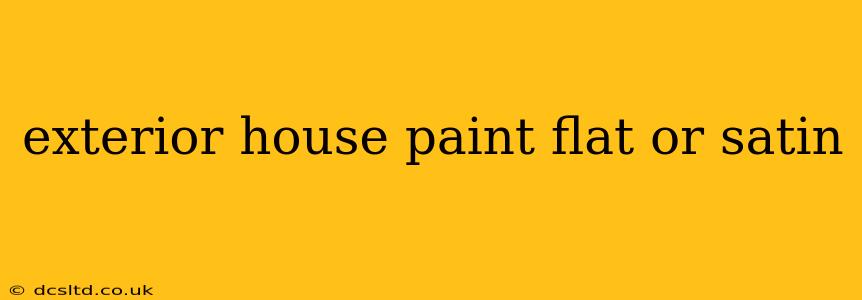Choosing the right exterior house paint can significantly impact your home's curb appeal and longevity. One of the most crucial decisions is selecting the sheen: flat or satin. Both offer unique advantages and disadvantages, making the choice depend heavily on your priorities and home's specific needs. This guide will break down the key differences to help you make an informed decision.
What is the difference between flat and satin exterior paint?
The main difference lies in the level of sheen or gloss. Flat paint has virtually no shine, offering a matte finish. Satin paint possesses a low-luster sheen, appearing slightly glossy but not as reflective as semi-gloss or gloss paints. This subtle difference impacts several key aspects of performance and aesthetics.
Which is better for exterior walls? Flat or Satin?
There's no single "better" choice; it depends on your priorities. Here's a breakdown:
Advantages of Flat Exterior Paint:
- Excellent Hiding Power: Flat paint excels at concealing minor imperfections in the wall surface. This makes it ideal for homes with textured siding or older surfaces requiring a touch-up.
- Elegant, Classic Look: The matte finish provides a sophisticated, understated appearance that many homeowners find appealing. It's particularly well-suited for traditional home styles.
Disadvantages of Flat Exterior Paint:
- Difficult to Clean: Flat paint's porous surface makes it challenging to clean. Dirt and grime tend to embed themselves, requiring more vigorous scrubbing that could potentially damage the finish.
- Less Durable: Compared to satin, flat paint is less durable and more susceptible to damage from weather and wear. It may require more frequent repainting.
Advantages of Satin Exterior Paint:
- Easy to Clean: The slightly glossy surface makes satin paint easier to clean. Spills, dirt, and mildew can be wiped away relatively easily without damaging the paint.
- More Durable: Satin paint offers better resistance to weathering, scratches, and scuffs, extending its lifespan compared to flat paint.
- Better Mildew Resistance: The smoother surface of satin paint makes it less prone to mildew growth, a common problem on exterior walls.
Disadvantages of Satin Exterior Paint:
- Shows Imperfections: Satin paint's slight sheen highlights any imperfections in the wall surface more than flat paint. This means careful surface preparation is essential before painting.
- Less Forgiving: Unlike flat paint, satin paint won't hide minor imperfections as effectively.
What are the common uses for flat and satin exterior paints?
- Flat paint: Often preferred for less-exposed areas or homes where a classic, low-maintenance look is desired. It's also a good option for textured surfaces.
- Satin paint: Typically chosen for high-traffic areas or homes in climates with harsh weather conditions where durability and easy cleaning are essential.
How long does flat and satin exterior paint last?
The lifespan of both flat and satin exterior paints varies greatly based on several factors, including the quality of the paint, weather conditions, and proper surface preparation. Generally, however, satin paint tends to last longer than flat paint, potentially by several years.
Does flat or satin exterior paint fade less?
While both paint types can fade over time due to sun exposure, neither is inherently superior in fade resistance. The quality of the paint (pigment concentration, UV protection) is a far more significant factor affecting fading than the sheen level. Always choose a high-quality exterior paint with excellent UV protection.
Should I use flat or satin paint for my trim?
Satin is generally preferred for trim due to its superior durability and cleanability. The slightly glossy finish is also more resistant to chipping and scuffing, which are common occurrences on trim.
By carefully considering these factors, you can choose the exterior house paint finish that best suits your home's specific needs and your personal aesthetic preferences. Remember to always prepare the surface thoroughly before applying any exterior paint to ensure optimal results and longevity.
